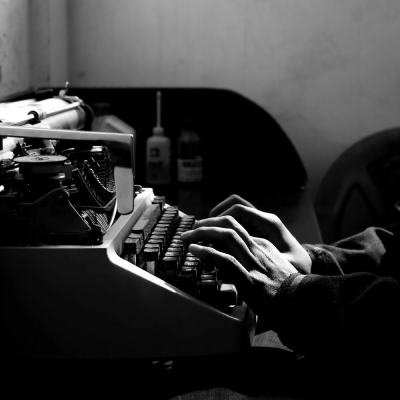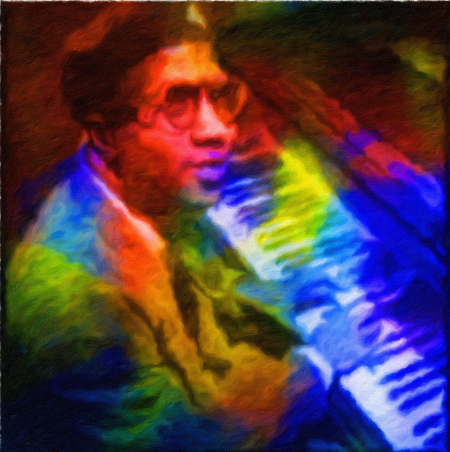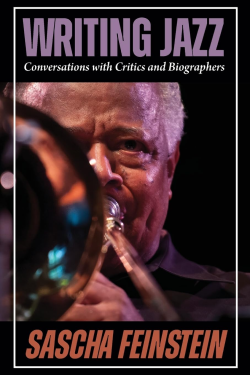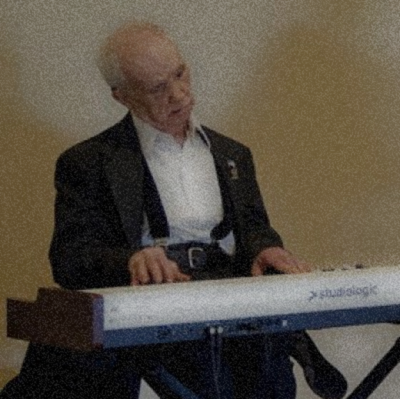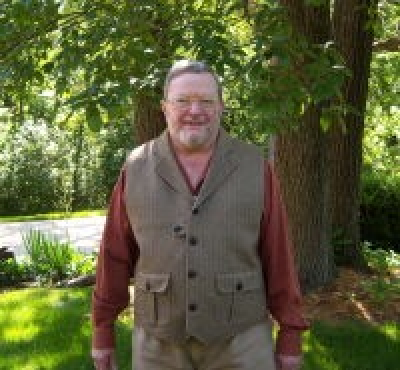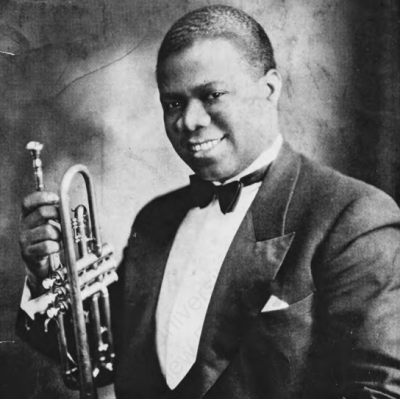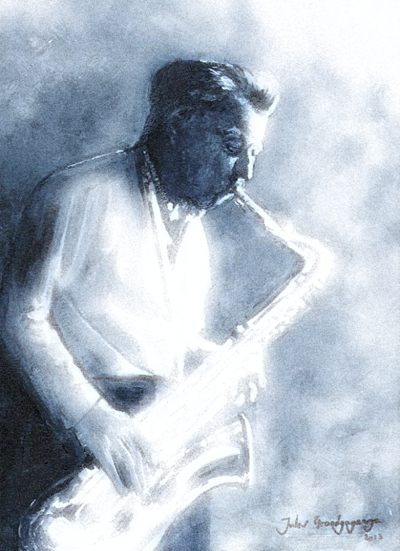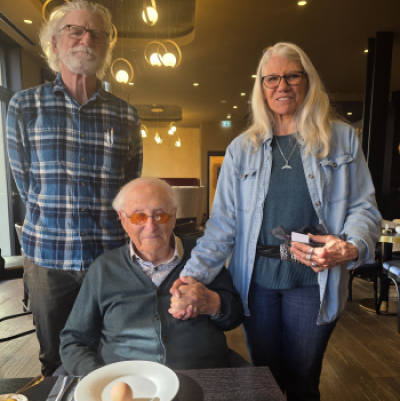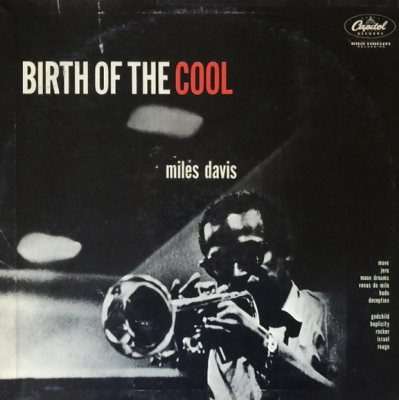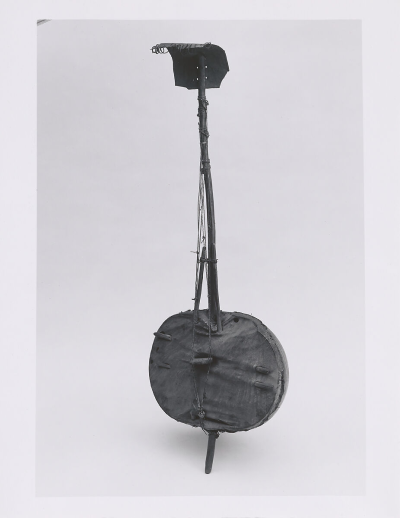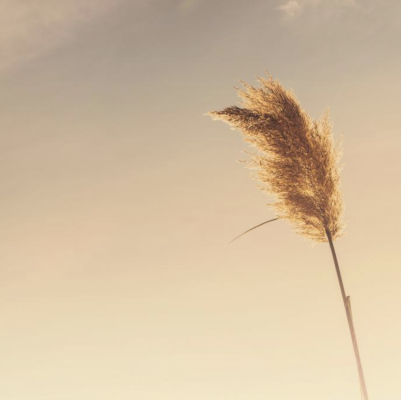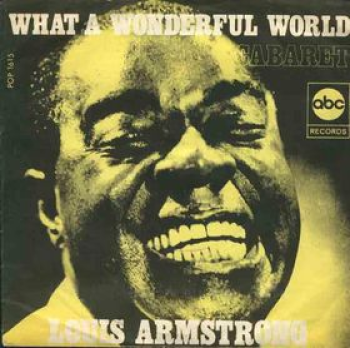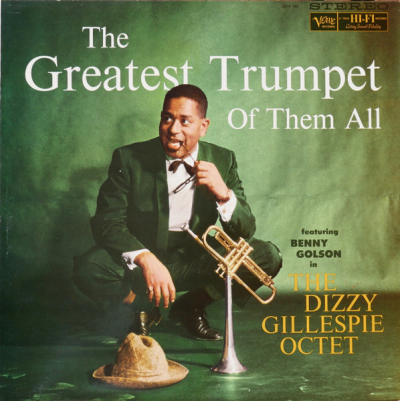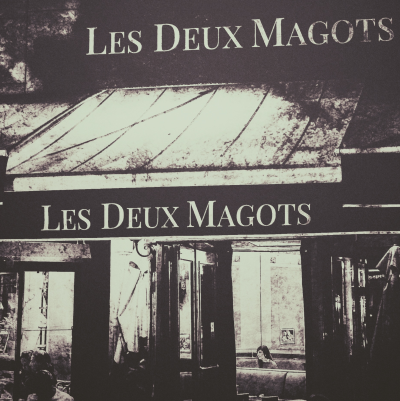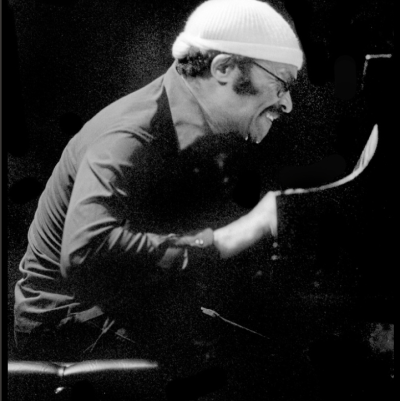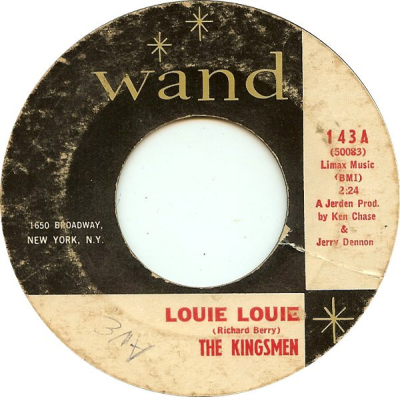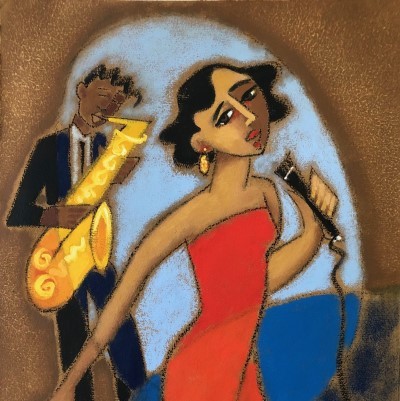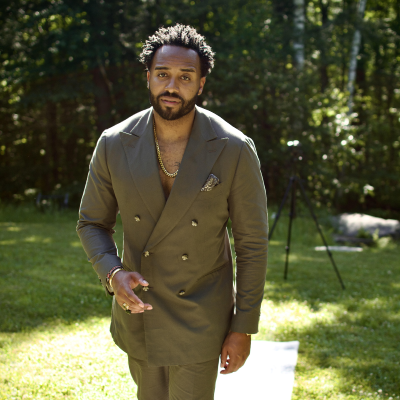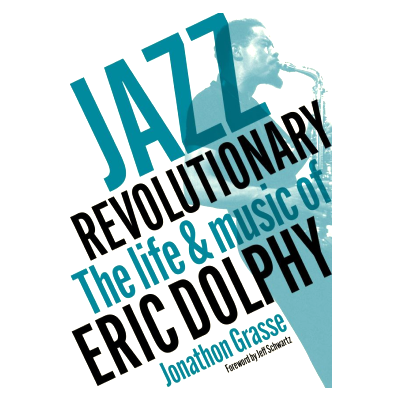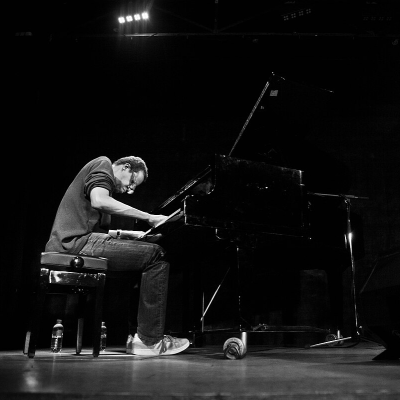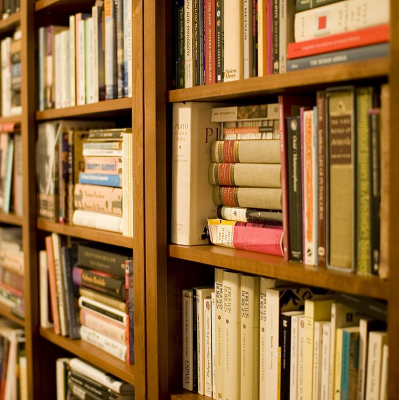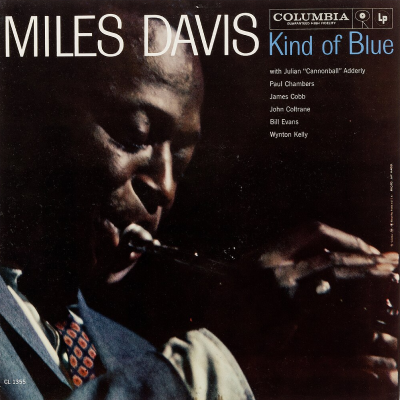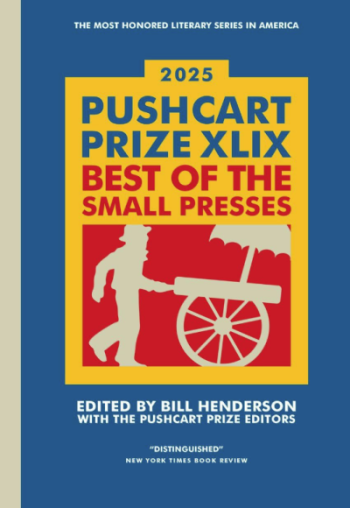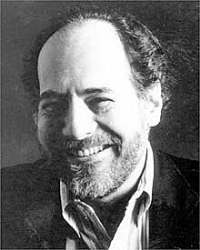
Village Voice writer Gary Giddins, winner of the National Book Critics Circle Award, and who is the country’s eminent jazz critic, joins us in a June 21, 2002 conversation about jazz great John Coltrane.
Conversation hosted by Jerry Jazz Musician publisher Joe Maita.
____________________
JJM Let’s talk a little about John Coltrane…This quote comes from an essay of yours on Coltrane called “Metamorphosis.” “He pushes himself and the blues to the limits of endurance, drawing light from dark, pleasure from pain, liberation from constraint.” There is no clearer way to describe the work of John Coltrane. What is your personal memory of the first time you heard his landmark recording A Love Supreme?
GG I had been listening to Coltrane for a couple of years, and quite intently when A Love Supreme came out. Everybody knew it was special, simply because it had a white spine. This was the old days of Impulse Records when all other releases had an orange spine. Instead of the usual liner notes, it had a big charcoal drawing of Coltrane and this odd poem by Coltrane which, to one’s astonishment, was very candid and self-revealing, in the form of a cantata, a hymn, an ode. Then, of course, after listening to it a couple of times, I realized that “Psalm,” the fourth movement of A Love Supreme, is in fact a musical setting of that psalm. He put the psalm on the music stand, apparently, and improvised a note for every syllable of it. If you listen to it and read along, you will see that it fits exactly. I think the first time I heard A Love Supreme, it didn’t seem to me, other than all that hoopla I just mentioned, some tremendous advance, because he had been making great recordings for so long. It didn’t seem like a great transition in the sense that Ascension did, or Meditations, or even “Chasin’ the Trane” in 1961. It just seemed to be a kind of perfect manifestation of where Coltrane was going at the time. The whole quartet was beautifully featured, each musician in a sense is featured in a different movement, and it had great tunes. That’s the other thing about Coltrane he was a great jazz composer who created original and unforgettable melodic ideas, which is something you can say about relatively few jazz musicians. A Love Supreme is just filled with them. It had vocals, it had the group chanting “A Love Supreme,” which was completely novel at the time. Everything about the record lets you know that this was an important event. I loved it, but I can’t say that it struck me as some new turning point.
JJM How did the critics respond to it?
GG The critic response was interesting. I remember Downbeat gave it five stars. Downbeat had been very hard on Coltrane for several years, and I think this was the first time they had given him five stars in a long time. The irony of A Love Supreme, in a way, is that everybody accepted it almost instantly as a masterpiece. This was the Coltrane record everybody was waiting for. Everything about the record worked. Remember, this was the day of the LP. I shutter to think that if he had recorded this as a CD. It would have been seventy minutes long and lost the gorgeous economy, because that is a record that in one sitting can completely knock you out. There isn’t a wasted note. Everybody accepted it as a masterwork, and this is where Coltrane is going, and this where he is. Just as everybody was applauding themselves for being so perspicacious in appreciating Coltrane’s genius, he does this complete turnaround and knocks them all off their feet with disbanding the quartet, bringing in musicians that a lot of people couldn’t understand, and of course, releasing Ascension, which is just a shocker.
JJM It’s unlistenable to many of us. I know you got into it after four or five listens, but I could never get quite that far.
GG I played that thing to death, and then when I heard that second take! I remember a couple of us were in a record store in Chicago during spring break. I had a razor blade and I was secretly slitting the plastic and sliding it out to find the second take. You could only find it if it was engraved on the vinyl. After a while, when they sold out the first take, you could only buy the second take. Bringing home the second take was a big deal, because we listened to the first one to death. It was very easy to hear how different it was. To me, Ascension, if you listen to it a lot, was a record that mostly young people got into because only young people had the patience. It really forced you to question all your assumptions about what constitutes a musical work. But then you have, years later, the Rova Quartet transcribing it note by note and recreating it for a saxophone quartet! One thing that Ascension proved, the way extreme modernism does in any field of art, literature, painting, is that once you know or hear something, it doesn’t matter if it was made up at the moment, the notes have their own integrity. That’s what Rova proves. When I hear Ascension, I have this tremendous sense of familiarity. I don’t play it very often, but I played it so much when it first came out, that I listened to it right away, and I know what’s coming. There are a lot of ironies in this record that are well worth exploring. For example, the fact that Freddie Hubbard, who is at his peak when he made that record, and who is one of the great trumpet virtuosos in jazz history, played very badly. Whereas Dewey Johnson, who is a second rate player who I don’t think ever made another record, is quite effective on it. Freddie Hubbard can not think outside of certain harmonic ideas that Coltrane is trying to obliterate.
JJM Yes, Hubbard didn’t seem to know what to do…
GG That’s right, he doesn’t know what to play. Archie Shepp really turned in a superb performance, especially on the second take. The first take it sounds like he is just kind of screaming along, but the second take he sounds like he found his place. The rhythm section is astounding. You can get lost in some of the things that Elvin Jones and McCoy Tyner were doing. There was such intensity there, especially towards the final moment. But this idea of having a piece of music that goes from crescendo to solo to crescendo to solo is not that uncommon in jazz.
JJM The evolution of John Coltrane’s art is rather dramatic…You wrote that “throughout 1963 and 1964, Coltrane attempted, not always successfully, to blend the clamor and the serenity that infused his music.” Was A Love Supreme his first successful blend of “clamor” and “serenity”?
GG I don’t think so. I remember “Spiritual” on the Live at Village Vanguard album I think you can say that of “Giant Steps,” and certainly of “Alabama.”
JJM You may be able to say that of “My Favorite Things” as well?
GG Absolutely. That is an amazing performance. Every time I go back to it, I am just stunned all over again at how innovative it was, especially in the context of the time. There is not the faintest note of irony in that performance. It is not like he said he would take “The Sound of Music” and do something else with it. He really heard that tune as though it were something he might have written. The whole arrangement of it. The piano It took a long time to understand what McCoy Tyner was doing on that, because his solo was basically a strict-constructionist take on the melody, but it really is so perfectly timed. It’s brilliant.
JJM What influence did Coltrane’s recording of A Love Supreme have on Impulse? Was the direction they headed more of a musical or political statement?
GG The next time they did a record without an orange spine, I think, was when they recorded Zoot Sims. I loved Zoot, but it wasn’t even one of his best records. I think in that choice you see that Bob Thiele (of Impulse) was basically a pretty conservative jazz listener and producer who trusted Coltrane completely, and I think realized that Coltrane was probably the best artistic relationship of his career. He trusted Coltrane to sign other musicians who were playing the kind of music I don’t think Thiele deeply loved. I could be wrong, but that is the way I hear it.
JJM Do you think he recorded them as musical or politcal statements?
GG Absolutely musical statements. Even the political statements are musical statements. The Archie Shepp stuff clearly is an attempt to have a political ramification. He made records like Attica Blues and Fire Music, but those are entirely musical or they would be completely worthless. The records that are primarily political statements just don’t stand up.
JJM The critic Ira Gitler described Coltrane’s music at one time as “sheets of sound.” How do you describe what Gitler meant by “sheets of sound” so an average listener would understand?
GG It’s a lovely phrase, and it has been quoted so many times that I think many people don’t even know who coined it. He is basically trying to suggest the idea that Coltrane was a guy who was addicted to Nicolas Slanimsky’s “Dictionary of Chords.” He played them over and over, practicing hours at a time. He figured out a style of music that consisted of hitting just about every note and every chord so it creates this tremendous mass of notes, and the incitement in the music becomes not a question of following a linear line through a set of chord changes, but in hearing all the implications of the harmony. It’s like you can only play one note at a time, yet you are playing so many notes that every implication of the chord is hit rather than just a series of notes that give you a melodic phrase to follow. Later on, around the same period in rock and roll, when Phil Spector was producing those girl-group records with strings, somebody coined something like “wall-to-wall sound.” I think that was the similar idea that Gitler was trying to get with “sheets of sound.” It is in violation of the usual idea of somebody like Lester Young, who picks just the one perfect note from every chord and creates his own new melody, which is frequently superior to the melody he is playing a variation on. Coltrane could do that. I especially loved the ballad performances on Prestige, but when you hear a performance like “Soft Lights and Sweet Music,” where he starts up real fast, playing Irving Berlin’s melody for all it’s worth, and playing it as it is written, and then he just builds and builds until finally he is into a whole different place… “Sheets of sound” is about as good a phrase as you can get to describe it.
JJM Two different record companies with two widely differing styles, Atlantic and Impulse, released Coltrane records simultaneously.
GG Yes, that was very interesting. I remember when The Avante-Garde came out, we were so confused, wondering if it were possible this was a new record on Atlantic, then to read the small print and realize this was sitting in the vault for four or five years. If you were following Coltrane at that moment, you were getting “present-day Coltrane” on Impulse, and you were getting a kind of “rear-view Coltrane” on Atlantic. Then, of course, there were reissues coming out from Prestige, and the Blue Note stuff, which allowed you to fill in on other places.
JJM His fans must have been incredibly confused
GG Very confused, but then if you went to see him live, your confusion was magnified a thousand fold, because it turned out that “present-day Coltrane” was always six months behind what he was really doing.
JJM And what he was doing live was so much different than anything he was doing on his recordings.
GG I went to the legendary concert called “The Titans of the Tenor” on February 19, 1966. I will never forget that evening for as long as I live. It was a Saturday night at Philharmonic Hall, which had one of the worst acoustic set-ups of any major concert hall. It was later destroyed and turned into Avery Fisher Hall. I believe the concert started at midnight. The advertised saxophonists were Zoot Sims, Coleman Hawkins, Sonny Rollins and John Coltrane. Even though the concert was called “Titans of the Tenor,” the producer for some reason also stuck in the Clark Terry and Bob Brookmeyer Quintet. I don’t know what that was about. Zoot and Hawkins did their bit, Sonny played thirty minutes during which he brought out unannounced guest Yusef Lateef. The first set was terrific. The second set was going to be Coltrane, and the emcee Dave Lambert said Rollins would come back to play with Coltrane. So, we were all sitting there expecting to see Jimmy Garrison, Elvin Jones, and McCoy Tyner. Instead, a dozen guys walk out there, with Garrison being the only one from the Quartet. He had two drummers, Rashied Ali and J.C. Moses, we didn’t know about that. Interstellar Space wasn’t released for years after that. Alice Coltrane was on piano, and nobody knew about her, at least us kids. We only knew of the records. We knew when you went to Sam Goody and bought the new John Coltrane record, we thought that was what was going on. So, he comes out with all these people – the Ayler Brothers Man! To this day, I don’t think I will ever go into shock the way I did that day. Dan Morgenstern was there, and we talk about it and still joke about it. Dan just hated it. He was so offended and thought it was insulting to the other musicians. But, me, I was about 18 years old at the time. I was with my girlfriend and we turned to each other afterwards, and we both decided we loved it but were a little ashamed of loving it because we couldn’t explain it. We weren’t even completely sure it was music, but we felt invigorated. It was thrilling. There was a guy in a wheelchair holding up a brown paper bag, obviously a bottle in it. We had fifth or sixth row seats, near the center aisle, and he wheels up right up to that row, and Coltrane and the whole group got into some kind of rhythmic thing, and this guy started chanting. He was holding the brown paper bag like in a power fist, over his head, and he starts chanting, “Coltrane, Coltrane, Coltrane.” It was perfectly within the time and nobody was upset because it sounded like he was a member of the band!
JJM Sure. You didn’t want to disturb him because he may have been part of the show
GG It was incredible! It was musically perfect. I remember a lot of things from this concert. At one point, in the middle of an extraordinary solo, he was doing deep knee bends and calisthenics when he played. He is doing this and in the middle he started playing about four bars of “My Favorite Things.” The place went mad! People were cheering and screaming and yelling. Before the cheering died down, he was already off that.
JJM What was that about?
GG I thought about that a lot, and I think it’s a way of Coltrane telling the audience that he isn’t a different man, that we all remember this, that we are all on this same trip together, that he is not repudiating anything he did, but that he is doing something else now. I think the audience recognized that as such, that they are on this trip with this guy who is moving someplace. Unlike all the other guys who were clearly in transition, like Miles Davis, who was moving inch by inch towards A Silent Way and Bitches Brew, and Bob Dylan, who goes from being a folkie to a folk-rocker, and The Beatles, who go from being authentic neo-fifties rock and roll to the art rock, psychodelic stuff. They were all moving toward the center, toward rock and roll, the mainstream, where the money is. Coltrane is the only guy who is moving in the opposite direction.
JJM Your interpretation of those four notes he played of “My Favorite Things” is very interesting…He is the same guy that brought that music, but now he is creating this…
GG Yes, it’s a speculation but I think that certainly may have been going on because he did it all the time. He wasn’t afraid to go back and play tunes, because if you listen to the Seattle or Japan concerts, he was still playing “Out of This World” and things like that. I don’t think he was trying to “kill off” something. When he died, they realized he was in tremendous physical pain for years, and I think that probably influenced him too. A lot of guys tried to imitate him who sounded like they were in pain! Coltrane was such an honest musician, that he was always playing what he felt emotionally, mentally and physically. All of that goes into it. I remember Coltrane, during his concert, was involved in sort of blocking out every other kind of sound. It’s like a kind of purgative, a cleaning out of your brain of everything you think you know about music. It’s not that far from what Schoenberg was trying to do sixty years earlier. One thing about this Coltrane concert, that I have to say, is that a couple of weeks later, this same girlfriend of mine and I went to see a Broadway musical. We were really tired for some reason. We got there early and while sitting, I sort of dozed before the show started, and I started to hear this incredible music which brought me back to wakefullness, and it took me about ten seconds to realize I was listening to the orchestra tuning up! Again, I realized that there was this idea of “found” music, something that John Cage had been talking about. Aldoux Huxley wrote a magnificent essay back in the twenties, where he reviewed a nightingale perched on a tree outside his office. This idea of found sound is real, and I think one of the effects Coltrane had on me was that suddenly, even though they are just tuning up, you are listening to notes, you are listening to music. You don’t want to make too much of it, but it does open up your brain to hearing things beyond the temperate scale.
JJM You quote Coltrane as saying, “The main thing a musician would like to do, is to give a picture to the listener of the many wonderful things he knows of and senses in the universe.” Where do you believe Coltrane was headed with his music?
GG Isn’t that the $64,000 question? When he died, it was like reading a mystery thriller and the last chapter had been torn out. Where in the hell was he going? Clearly, there was a greater and greater accent on a kind of religious, cosmic, thematic undercurrent. This, I confess, loses me, maybe because I am not particularly religious. Whereas I don’t believe you could ever say of Coltrane that he made a political work at the expense of the music, I think there were implications in Alice Coltrane’s work that music is secondary to some kind of religious notion. One of the few Coltrane performances that I find very difficult to listen to was Om. I just don’t believe it. That may be where he was going. We don’t really know. We do know that he was planning a trip to Africa, so he might have been on the very first wave, along with Ellington and the pianist Randy Weston, of a kind of world music synthesis. I don’t think he would have gone toward fusion. I find that unbelievable, but that could be my own prejudice. I think he would have made a kind of truce with his past as most musicians have done, and we would have seen him playing a lot of ballads as he did in ’62 and ’63. I don’t think you can have an entire lifetime of Ascension. I do think that Coltrane was running on borrowed time. I don’t think he had any doubt that his days were numbered. I think he was trying to make the loudest sound he could make in those last moments.
________________________________
Gary Giddins products at Amazon.com
John Coltrane products at Amazon.com
_______________________________
Interview took place on June 21, 2002
*
If you enjoyed this interview, you may want to read our interview with saxophonist Joshua Redman.





